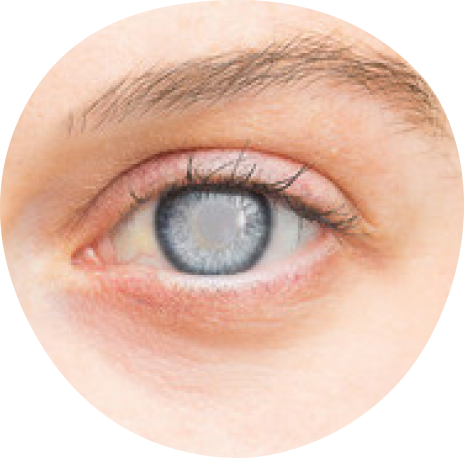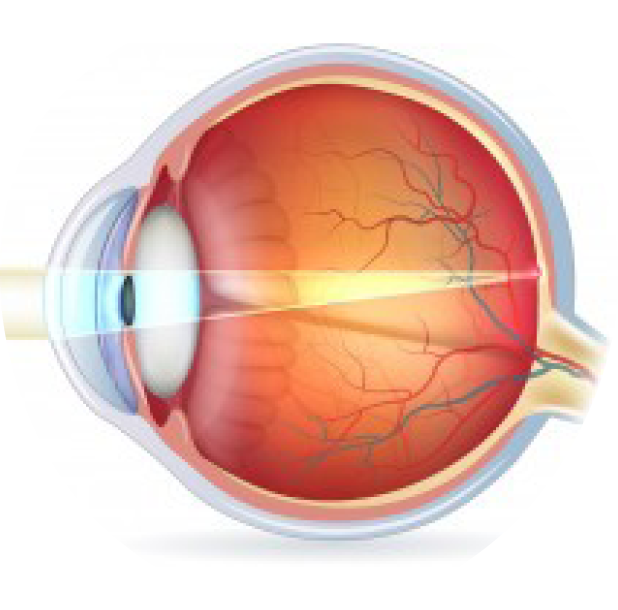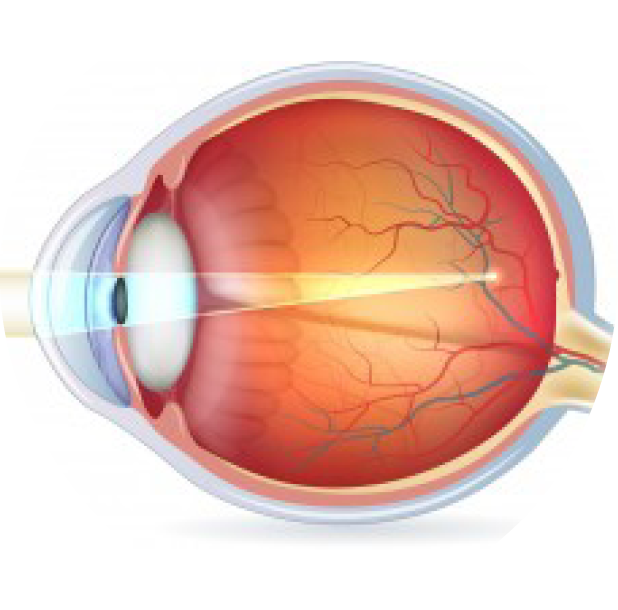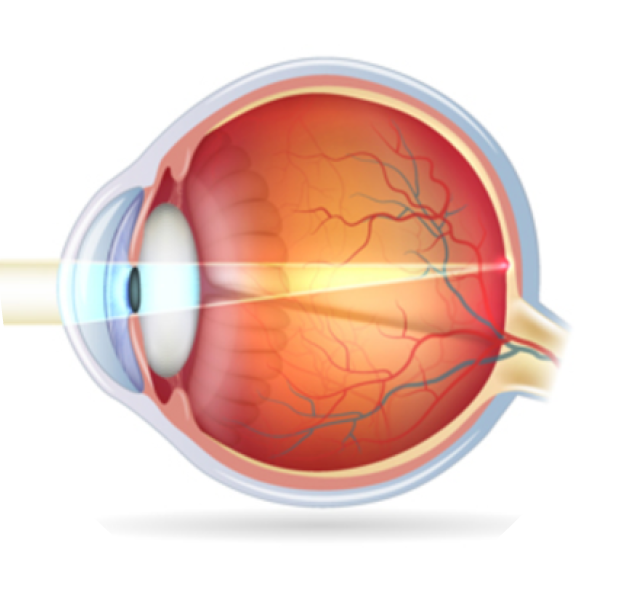Look after your eyes
Unless your vision has changed, you may not give your eyes much thought when it comes to health. That’s why it’s so important to have your eyes tested regularly.
Cataracts

Eye without Cataract

Eye with Cataract
Cataracts occur when the lens inside of the eye responsible for focusing the image on the retina becomes cloudy.
It is not hereditary and it is not a growth in the eye. It is a change in the eye where the naturally clear lens becomes cloudy: like looking through a dirty window. In the early stages you might not have any symptoms; but as the cataract progresses the vision will begin to get blurry and glasses will not fix the problem. Cataracts mainly occur as you get older normally after the age of 60; they can however occur earlier or secondary to trauma.
Cataracts are only correctable by surgery. This involves removing the natural cloudy lens of the eye and replacing it with a clear artificial lens, known as an Intra-Ocular Lens.
Ready to check your eyehealth?
Macular degeneration
Macular degeneration occurs when the area of the retina responsible for precise central vision when looking at things straight ahead gets damaged.
In some cases the central vision can appear distorted, but when at its worse there can be a complete loss of central vision making it impossible to drive. Fortunately it only affects the central portion vision and not the peripheral vision. It is caused by a number of factors, however, genetics, sun, nutrition and smoking may play a role in the health and integrity of the macula area.
Ready to check your eyehealth?
Glaucoma
Glaucoma is an eye disease where the pressure inside of the eye, Intra-Ocular Pressure, causes progressive damage to the Optic Nerve at the back of the eye.
The pressure usually increases when the drainage of fluid from the eye is inadequate causing a rise in pressure. Gradual but permanent loss of vision can occur unless treatment is started.
A Glaucoma check is part of a usual eye examination and consists of an evaluation of the Optic Nerve, a measurement of the Intra-Ocular Pressure and an assessment of the Field of Vision.
Glaucoma can occur at any age but the risk increases as you get older.
Some people are more at risk of developing glaucoma than others if they have,
- Family history of Glaucoma
- Diabetes
- High blood pressure
- Thyroid problems.
Ready to check your eyehealth?
Diabetes
One of the most distressing and difficult complications of diabetes is reduced vision.
Diabetes weakens the walls of the blood vessels in the retina. It can cause bleeding of tiny blood vessels, bulging of vessels, leakage of fats and fluid into the surrounding tissues.
In severe cases, it can cause serious visual loss. Control of blood glucose levels and treatment of conditions such as high cholesterol and blood pressure can help save the sight. For more information about Diabetes visit www.diabetes.org.nz
Ready to check your eyehealth?
Here are some of the common vision problems we test for.
Myopia
(Short-sightedness)

The Perfect Eye

The Myopic Eye
The most common refractive error of the eye and is becoming more prevalent. A myopic, or short-sighted person, has trouble seeing clearly far away.
Usually, their distance vision will be blurry and reading vision will be clear.
In myopia light comes to focus in front of the retina (back of the eye) instead of on the retina. This may occur for two reasons; either the focusing system (the lens and cornea) is too strong, or the eye is relatively too long.
There are a number of ways to correct myopia, which may involve spectacles, contact lenses, or refractive surgery. Each of these options focus the light on the retina, making the distance vision clear.
The exact cause of myopia is still not clearly understood. Fortunately, we are learning more and there are now treatment programmes which have been shown to slow the progression of myopia, especially in children. These Myopia Control options include Orthokeratology, Atropine eye drops, soft contact lenses, and Miyosmart spectacles lenses.
Myopia Control is a very exciting new area of optometry and we are happy to discuss these possibilities with you.
Ready to check your eyehealth?
Hypermetropia
(Long-sightedness)

The Perfect Eye

The Hyperopic Eye
A hyperopic person, or a person with long-sightedness, usually sees quite well. Their distance and near vision will be clear.
Hypermetropia occurs for 2 reasons; either the lens system of the eye is too weak for the length, or the eye is too short for its optical power. This means that when the light enters the eye, the image is focused behind the retina.
For large amounts of long-sightedness, the eyes cannot make the extra effort that is needed to focus the light on the retina. This leads to symptoms of soreness, tired eyes, headaches, poor concentration with reading and computer work, and also some blurring of words when reading for long periods of time. Glasses are generally given to help with strain and effort when reading or on the computer, but can also be useful for distance tasks, like driving long distances.
Hypermetropia in Children
Hyperopia can commonly affect children. A low degree of hyperopia is expected in children, but occasionally, it may be present in large amounts, even in very young children. This can affect one eye, or both eyes. If these conditions are not detected it can lead to long-term, or even permanent, vision difficulties which may otherwise be readily treatable. These conditions include amblyopia or a ‘lazy eye’, where one eye is significantly weaker than the other, and strabismus or ‘squint’ where one eye turns in or out. Treatment options range from spectacle wear, to patching the stronger eye, to eye exercises
Unfortunately, often children do not know that they can’t see well and may pass simple vision tests, so early comprehensive testing is vital for early detection and treatment.
Hypermetropia in Older Adults
As we get older, the lens inside the eye stiffens and cannot be changed to focus the light on the retina. This can cause blurred vision in an eye which previously saw well. At this time glasses are prescribed for the blurry vision and/or any discomfort in the eye.
Ready to check your eyehealth?
Astigmatism

Normal Vision

Astigmatic Vision
Astigmatism causes blurred vision of both near and distance objects. It is caused by an irregular shape of either the cornea or the lens of the eye.
Normally it is spherical in nature like a soccer ball, but an eye with astigmatism is often described as being almond or rugby ball shaped. It can occur in combination with long or short-sightedness.
Astigmatism can make things uncomfortable and difficult to focus on and may cause headaches, poor concentration and tiredness, especially when concentrating on a particular task. Glasses can be prescribed to make the vision clearer and reduce symptoms.
Ready to check your eyehealth?
Presbyopia
(over Forties)
Most people notice that between the ages of 40 and 50 their vision changes rapidly. They find that reading at a normal distance becomes difficult and later blurry.
As we get older the lens inside of the eye stiffens and loses its flexibility making it harder to focus on things up close.
This is a normal and natural process. Reading glasses are prescribed. Some people choose to buy hobby glasses and find it adequate for their needs. These glasses, however, have the same strength in each eye and if the 2 eyes are different then using these glasses can add added strain to the eyes.
It is essential to have a full eye examination and let your Optometrist advise you the best solution to meet your needs. It is important to have the health of your eyes checked regularly even if you use hobby glasses as many sight threatening conditions have no symptoms.
Ready to check your eyehealth?
